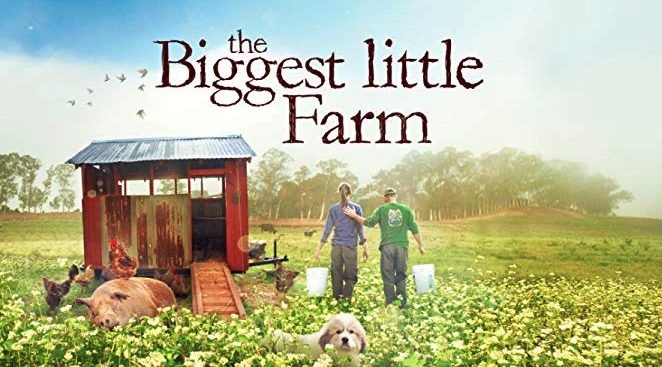By Tamanna Mohapatra
The Biggest Little Farm: Available on: Hulu, Run time: 91 minutes, Release: 2018.
More information at: https://www.biggestlittlefarmmovie.com

Directed and narrated by John Chester, a former documentary cinematographer, “The Biggest Little Farm” is both funny and hopeful. This film is almost like watching a dream, except real. Within the span of seven years, an ordinary couple creates a sustainable farm without very little background, just by applying one sustainable principle after another.
Located an hour outside of Los Angeles, the couple builds a self-contained ecosystem on 240 acres of land called Apricot Lane Farms. Initially, they search the internet for answers to questions they don’t know which proves to be a useful strategy. Shortly thereafter, they find themselves a perfect farm guru who instills a few but critical sustainability measures within them, such as focusing on biodiversity. They plant 75 varieties of fruit trees, raise multiple different animal species, use compost as the sole means of soil enrichment, and plant cover crops to protect the soil from wind storms and floods. This last step proves especially useful when flooding occurs as their farm is the only one that does not witness soil erosion, while all other farms in the surrounding areas lose precious topsoil.
As the film progresses, the couple learns the importance of every species on their farm, including the predators who keep pests under control. Their story is truly a unique one, built on interconnectedness, impermanence, and transformation. At one point, John admits, “Our farm is energized entirely by the impermanence of life.” To me, this is the biggest learning: every living being (predators and pest included) plays a part in nature, so we must all learn to live in harmony with one another.
Kiss the Ground: Available on: Netflix, Run time: 1 hr, 24 mins, Release: 2020.
More information at: https://kisstheground.com/
Told through the voice of actor Woody Harrelson, this movie is about the power of regenerative agriculture to help mitigate climate change, replenish our dwindling water supplies, and feed the world in a more sustainable manner.
Current agricultural practices in the US cost taxpayers $25 billion in farm subsidies, cause food waste from excess production and improper distribution, lead to water pollution and finally, soil erosion (which as the movie states is “when soil becomes dust”).
At present, 5% of US farms are managed for soil health; this needs to grow to 50% by 2025.
The solution proposed is that regenerative agriculture practices will capture carbon in the soil, essentially becoming a CO2 drawdown solution. There are also tips for all of us to help in this process, such as adapting a more plant-based diet and composting. Gabe Brown, a well-known regenerative rancher with many TED talks to his name, explains the basic principles behind regenerative agriculture as being four-fold. These are: applying no-till systems (the least amount of mechanical disturbance), crop diversity, planting perennials and trees, planned livestock grazing that promotes bio-sequestration (the process of capturing and storing carbon in plants), microbes and other organisms.
Zimbabwean ecologist and farmer Allan Savory say that using livestock can reverse desertification, which is currently happening all over the world and is scalable to ⅔ of Earth’s land at an extremely low-cost.
The film offers an oversimplified solution “of soil health as the solution to climate change”. It also fails to mention federal policy failures and big-age lobbying success in perpetuating the current industrial agricultural system.
Overall it’s an educational and inspiring movie; it shows how important soil is and the big part that we as consumers play in relation to it. However, it’s important to learn the biggest impact, which is the need of the present and future which can only happen with proper policy, plus significant public and private investments.
Be sure to attend the GreenHome NYC forum in July to learn more.
